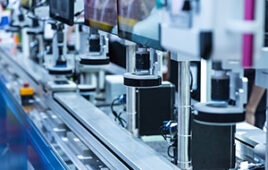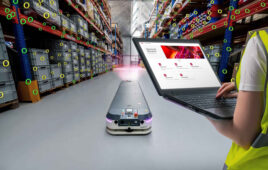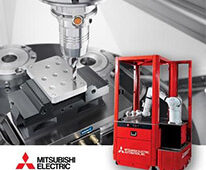Shortages of skilled labor can be addressed by investments in automation at the edge.
By Vibhoosh Gupta, Emerson
Worldwide unemployment is at a 50-year low in many countries across the globe, and many machine builder original equipment manufacturers (OEMs) and their customers are finding it very difficult to attract and retain skilled labor. For example, Emerson surveys show 48 percent of their customers have a talent gap for the important task of gathering, consolidating, and acting upon the disparate data produced by automation systems. A dramatic increase in labor productivity is required to address this and other issues, driving automation investment trends and initiatives across the globe.
These initiatives are often labeled as the industrial internet of things (IIoT) in the Americas and Industrie 4.0 in Europe, with both characterized by integration of more intelligent online devices, beyond those needed for basic real-time control. Emerson surveys show an awareness of this need, with more than 70 percent of industrial companies judging it critical to have an IIoT strategy in place by 2021. The goal is to reduce risk while increasing efficiency through digitization, with edge computing often used for decentralized data analysis.
Even countries thought to have vast supplies of labor, such as China, are experiencing shortages of skilled labor, driving investment initiatives to automate and digitize manual operations.
These investments will add to the already large and constantly growing store of data, with surveys showing only five percent of industrial automation data is currently used to improve operations.
Here’s a look at how edge control can be used to improve automation system architectures and productivity in industrial plants and facilities, often through better use of data.
Edge gateways, devices, and controllers
Figure 1 depicts a modern automation system architecture. The bottom left of the diagram shows a traditional control system with sensor, actuator, and other field device data supplied to a real-time control system. This type of system can provide data to an edge component, enabling analytical insights.
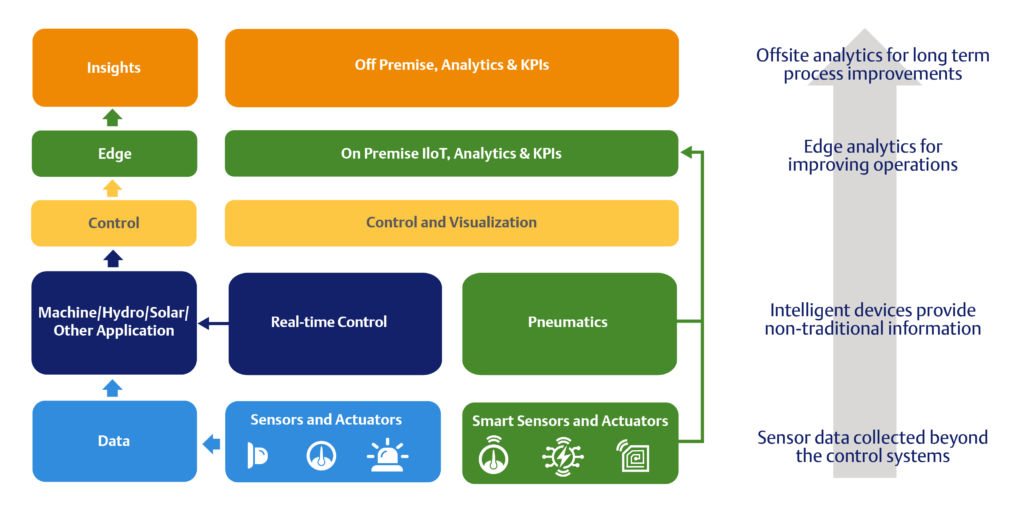
Automation system architectures are evolving to incorporate smart devices in parallel with traditional real-time control systems.
The bottom right of the diagram shows how other sensors, actuators, and field devices—usually of the smart variety—can supply data directly to an edge component, bypassing the real-time control system, with the edge component using this information to provide analytical insights. Smart devices are connected to edge components through digital data links, allowing these devices to supply extended information in addition to the process variable, such as status and diagnostics.
Edge components can be one of three types, described herein order of increasing cost and functionality.
An edge gateway simply collects data from field devices and real-time controllers, such as programmable logic controllers (PLCs), and forwards it to other systems for analysis. Although it only performs data collection and forwarding, these tasks require the capability to connect to many different types of field devices, controllers, and systems through a range of industrial digital protocols.
An edge device (Figure 2) provides all of the functionality of an edge gateway and adds processing and configurability capabilities, making it possible to collect and analyze data locally.
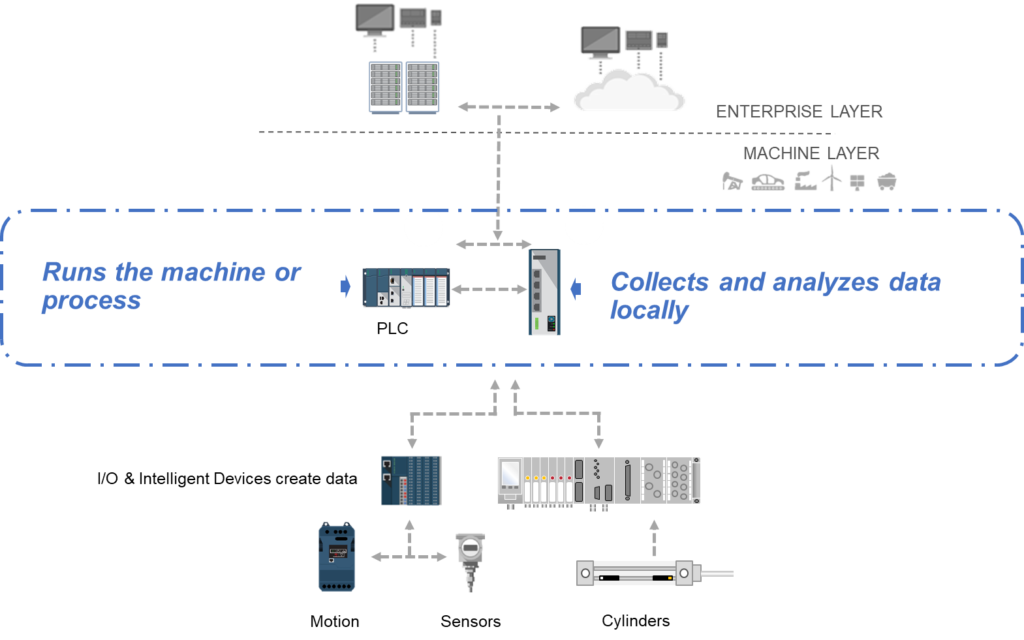
An edge device supports many different industrial automation protocols, and it can also analyze data locally.
An edge controller (Figure 3) provides all of the general-purpose computing functionality of an edge device, and it adds a real-time controller to execute deterministic control and logic operations. The embedded edge device can be used to optimize real-time control based on edge analytics and secure, real-time, access to outside information.
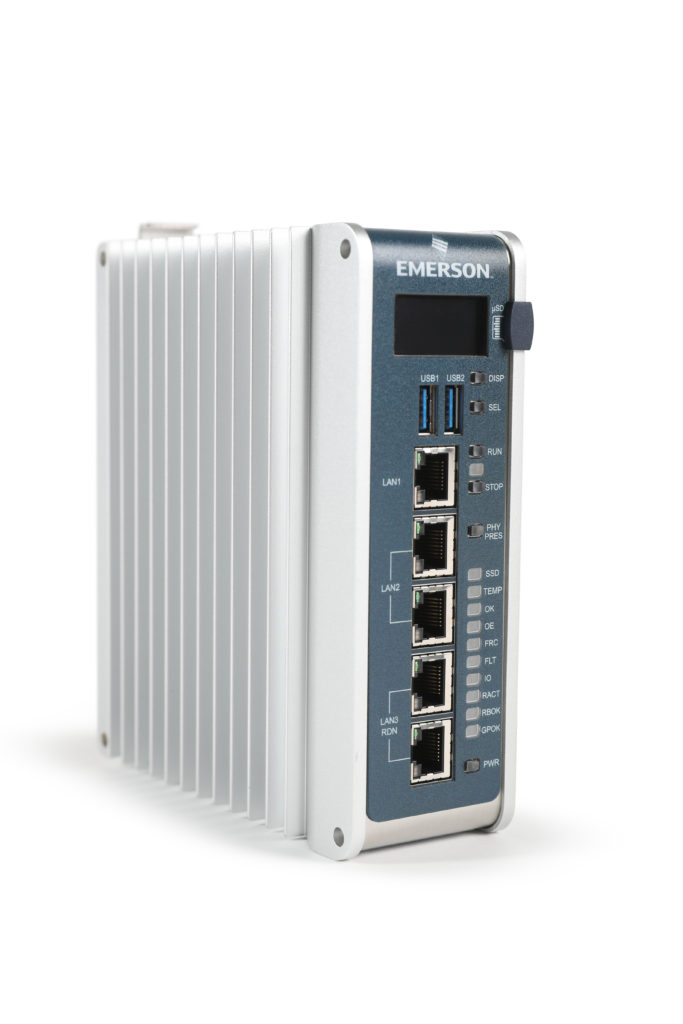
An edge controller provides real-time control, along with analytics and optimization. Figure 3 up and Figure 3 down. Emerson products. Photo/Andrew Shurtleff Photography, LLC

Connectivity to a range of field devices is provided through an edge controller’s support of industry standard fieldbus protocols. Multiple Ethernet and USB ports are independently assigned to either the real-time controller section or the edge device section, providing physically separate and secure communications.
Communication between the two sections of the edge controller are through OPC UA to maintain cybersecurity by separating real-time control from other functions. Separation extends to the operating systems, making it possible to reboot the Linux platform without affecting real-time control.
Resolving issues faster by improving collaboration
When a machine provided by an OEM to an end user experiences problems, finger pointing often results due to poor availability of operating information. For example, the OEM often believes the end user is operating the machine improperly, while the end user thinks the machine is not performing per specifications.
For one packaging machine OEM, the solution was adding new field devices to their machines in the form of pressure, flow, and vacuum sensors; fan motor vibration sensors; differential pressure filter sensors; and position sensors. Each of these sensors was connected to the edge controller. Data from these sensors was not used to directly affect machine control, but it was instrumental for improving the local operator interface for the end user’s operators and providing data to the OEM’s cloud, from where it could be securely accessed by the OEM.
The OEM and end user both have near real-time access to the same data, enabling collaborative problem solving. This improved visibility into the machine’s operation allows the OEM to deliver early diagnosis of problems before they escalate, reducing downtime and maintenance expenses. The end user can use this additional data to initiate procedural and tuning changes to machine operation, increasing throughput and improving quality.
Providing capability as a service
Many OEMs offer support for the machines they sell for a predefined period of time. While this arrangement works well in many cases, in other instances end users may prefer a higher level of service, along with lower upfront capital expenditures.
To address these and similar situations, some OEM machine builders provide capability as a service to end users, with payments contingent upon machine availability or uptime (Figure 4). The OEM thus assumes a very high degree of responsibility for machine operation, requiring a corresponding high degree of visibility into machine operations.
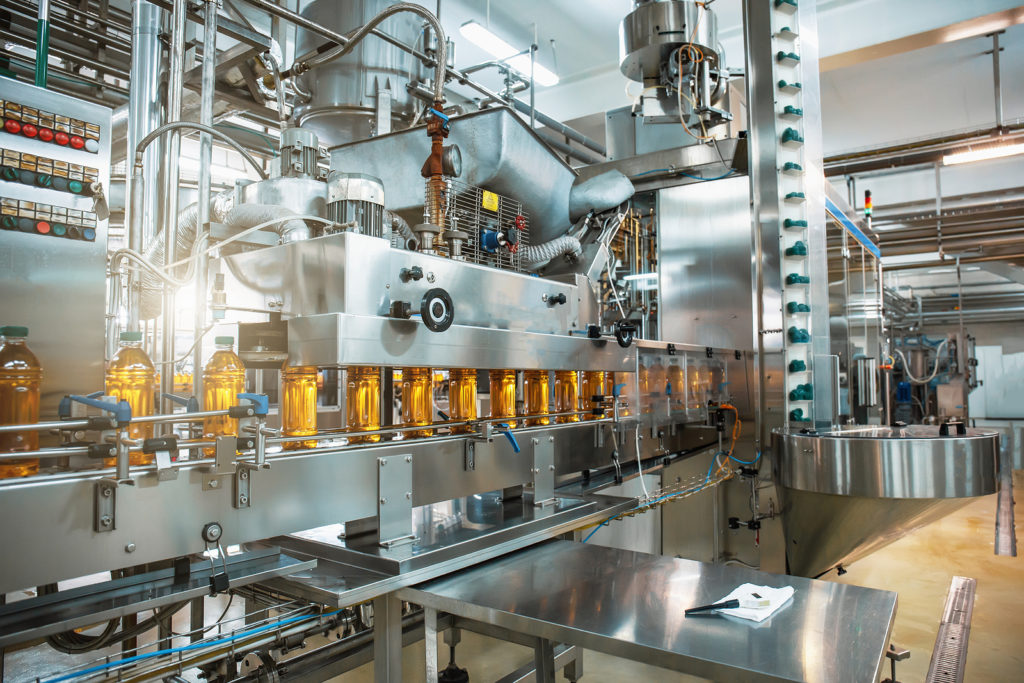
Edge controllers allow OEMs to provide capability as a service by providing extensive remote connectivity and visibility.
Edge controllers are a good fit for OEMs providing machines as a service because they combine reliable real-time control along with analytics at the edge and other functions. Virtually every aspect of machine operation can be monitored remotely, with the capability to make changes and adjustments as required to maintain uptime. Upgrades to improve performance can be performed remotely, saving time and travel cost.
Edge controllers enable new renewable energy solutions
Hydropower operations use turbine machinery for producing renewable energy from flowing water. Global demand for energy is expected to increase 50% between 2018 and 2050, and much of this demand will be met by renewables as they are expected to become the leading source of energy by 2050.
Unlike wind and solar, the cost to install additional renewable hydropower production capacity has not been falling recently. This is largely due to two factors. First, most of the best sites for developing traditional large-scale hydropower stations already have been developed, so increased capital investments are required to develop less-desirable generation sites Second, increasing concerns about environmental impacts of proposed new sites are driving up costs as more exotic mitigation schemes must be employed.
To remain competitive with wind and solar power, an emerging trend in hydropower is the installation of microgenerators with outputs as low as 10 kW, as opposed to the hundreds of kW produced by traditional hydropower installations. Hundreds of microgenerators can add up to significant amounts of power, equal to a large hydropower installation.
Importantly, these microgenerators are typically installed in existing canals, irrigation ditches, and other manmade water flows, drastically reducing environmental impact concerns (Figure 5).
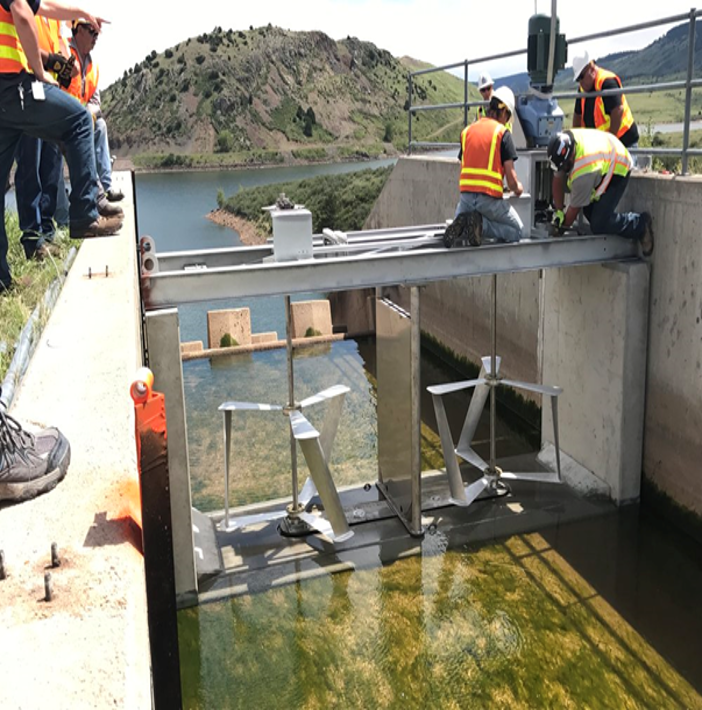
Hydropower microgenerators are typically installed in manmade water flows, such as irrigation ditches.
Because their power output is so low, hundreds or even thousands of sites must be developed, and then operated and maintained remotely to provide power economically. Edge controllers enable these types of applications as they can provide the required real-time control along with analytics at the edge and secure remote connectivity, all in one compact package.
Analytics at the edge makes it possible to derive the insights necessary for moving maintenance from reactive to predictive. This dramatically increases labor productivity, enabling a single technician to efficiently maintain scores of sites, and keeping costs low. An edge controller can capture sequence of events and other data from many microgenerators, and then send this information to the cloud for further analysis. Results across a fleet can be used to not only detect developing problems, but to also improve performance by increasing power output for a given level of water flow.
Shortages of skilled labor can be remedied in part by increases in productivity, which can be achieved by intelligent investments in automation. Edge components can be deployed in one of two ways to meet this need. For new installations, as in the hydropower microgenerator example, an edge controller can provide real-time control, analytics and optimization, and secure remote connectivity—all in one compact system. This is a much more efficient approach than using multiple components for control and other functions because these traditional approaches require integration between components, additional cabinet space, and added expense.
For existing installations—as in the machine builder example—an edge gateway, device, or controller can be installed alongside a real-time controller. This edge component can collect data from new field devices and from the existing real-time controller, and then securely communicate this data to other platforms, often cloud-based, for remote monitoring and analysis. If the edge component is an edge device or an edge controller, then analytics, optimization, and other functions can be performed right at the edge, with results transmitted to end users via existing local networks or the cloud.
In either case, labor productivity improves, allowing OEM machine builders and their customers to make better use of personnel while improving operations.
Emerson
www.emerson.com

Vibhoosh Gupta is a portfolio leader for Emerson’s machine automation solutions business unit and manages its portfolio of automation system, operator interface, industrial PC, and Industrial IoT software and hardware products for industrial automation.
Filed Under: Factory automation, Industrial automation

